6 Ways You Can Reduce Your Student Debt


Student loan debt can affect nearly every part of your life. The average U.S. borrower with federal student loans owes about $37,000. For undergraduate degrees alone, the average is closer to $21,500. Unlike many types of debt, student loans are very hard to erase—even bankruptcy usually doesn’t clear them.
The good news is that there are programs and strategies that may help lower what you owe or even forgive part of your balance. Here are seven options to consider if you’re struggling with student loan debt:
If you have federal Direct or FFEL loans, you might qualify for programs that can forgive large amounts of what you owe. One of the best-known options is Public Service Loan Forgiveness (PSLF). This program is available to people who work for government agencies or nonprofit organizations. If you qualify, the remaining balance on your Direct loans can be erased, and the forgiven amount is not taxed. To be eligible for PSLF, you must:
Note: Recent legislative changes have affected PSLF policies. You can find the most up to date information about PSLF on the Federal Student Aid website.
Another option for public student loans is income-driven repayment (IDR). There are four IDR programs:
Each program has slightly different terms and qualifications, but all of them can lower your monthly payment. A huge benefit is that your debt is forgiven at the end of an IDR program—20 or 25 years of payments, depending on the specific plan. However, forgiveness under an IDR is counted as taxable income.
AmeriCorps offers a path into public service by placing members in nonprofit roles for up to two years. While serving, you receive a modest living allowance (about $24,200 a year).
You can place your federal student loans into forbearance during your service, which pauses your payments. Interest still builds, but those months count toward Public Service Loan Forgiveness (PSLF) if you qualify.
When you finish your service and enroll in the National Service Trust, you may earn the Segal AmeriCorps Education Award. This award can help repay federal or state student loans or cover new education costs. The award amount equals the maximum Pell Grant for the year you served. Some schools also offer AmeriCorps Matching Programs, which can double the award’s value.
The Peace Corps is another option for public service. Volunteers commit to two years of overseas service plus three months of training, for a total of 27 months. You can extend your service if you choose to do so.
During service, you can request a student loan deferment, which pauses payments and prevents interest from building. However, deferment time does not count toward Public Service Loan Forgiveness (PSLF). A stronger option for many borrowers is enrolling in an income-driven repayment (IDR) plan while serving. This allows you to make reduced payments—even as low as $0—and still earn up to 24 qualifying PSLF payments.
After completing two years, you receive a readjustment allowance of more than $10,000, which you can use to pay down student loans or save. If you have Perkins Loans, up to 30% of your balance may be canceled after service, with the possibility of 70% canceled if you serve longer. The Peace Corps also offers the Coverdell Fellowship, which provides financial support for graduate school along with professional experience.
Volunteers also gain hiring benefits. For 12 months after service, you receive non-competitive eligibility (NCE) for federal jobs, giving you access to roles that are only open to government employees. Under the Peace Corps Hiring Benefit, you also receive preferential hiring at the Peace Corps itself for up to three years. Both benefits can help you secure employment that qualifies for PSLF.
Teach for America is a partner organization of AmeriCorps, specifically for teaching. You commit to teaching in an under-resourced K-12 school for two years. While you serve, you earn between $32,000 and $72,000 per school year directly from the school you work in.
Since Teach for America is an AmeriCorps partner, you get the same benefits. You can get a forbearance on your loans, with months in forbearance qualifying for PSLF. In addition, you may receive educational awards from AmeriCorps. A common use for that award is to pay for a teaching certificate.
Teach for America requires a bachelor’s degree, but you may be able to get help while you’re still in school. You can get up to $4,000 a year through the Teacher Education Assistance for College and Higher Education (TEACH) Grant Program. This requires a commitment to four years of teaching in a high-need field at a school serving low-income students.
If you have a doctorate degree in the health field and are engaged in research, you may be able to get loan repayment grants from the National Institutes of Health (NIH). NIH offers Loan Repayment Programs (LRP) for researchers, even if you don’t work at the NIH. If you’re approved, the LRP will repay 25% of your student debt per year, up to $50,000. The eligibility requirements are:
You can get help repaying your loan simply by relocating to a different city or state. It’s one of the easiest ways to get help with your student loan debt. Some places that offer programs for student debt repayment include:
Student loan debt can feel like a heavy burden, but you’re not without options. From forgiveness programs and income-driven repayment plans to service opportunities and state-level incentives, there are many paths that can reduce what you owe. Exploring these choices can help you find the right fit for your situation and make repayment more manageable.
The content provided is intended for informational purposes only. Estimates or statements contained within may be based on prior results or from third parties. The views expressed in these materials are those of the author and may not reflect the view of National Debt Relief. We make no guarantees that the information contained on this site will be accurate or applicable and results may vary depending on individual situations. Contact a financial and/or tax professional regarding your specific financial and tax situation. Please visit our terms of service for full terms governing the use this site.

Uncategorized Senior debt, a foundational element of most multifamily property acquisitions and developments, rarely covers the...

The end of the year is one of the most powerful moments to improve your financial life. A few intentional...

When it comes to escaping the grind of work, whether to tend to one’s responsibilities or to simply be, our...